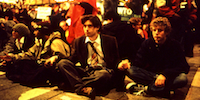Event

A conversation with Allan Sekula and Kaja Silverman
The title of this event comes from a short essay written by Kaja Silverman about Allan Sekula's Waiting For Tear Gas, a slide show consisting of 81 images taken in Seattle during protests against the World Trade Organization in the autumn of 1999. The conversation between Sekula and Kaja Silverman will be an occasion to ask how a work like Waiting For Tear Gas appears now in the light of the politics of occupation that have taken hold in our own moment, as well as a time to consider the shifting relationship between photography and temporality in Sekula's larger body of work on the operations of global capitalism, particularly at sea.
Since the early 1970s, Allan Sekula has theorized the practice of documentary photography as both an artist and a critic. He often works in essay form in order to challenge the apparent autonomy of the singular image; for example in "Untitled Slide Sequence" (1972) employees at General Dynamics emerge one by one or in small groups at the end of the day just as workers at the Lumière factory did nearly a century before. Sekula is also the author of a number of seminal essays including, "The Traffic in Photographs" (1981) and "The Body and the Archive" (1992). His trenchant critique of social documentary turns on his account of the tension between the technological and aesthetic discourses of photography. Sekula's prolific body of work has continued to revolve around issues of labor and the aesthetic and economic traffic in images bound up with the processes of globalization. In recent years Sekula has turned to the medium of film which has offered up new and rich means for bringing together image and word in works such as The Lottery of the Sea (2006) and The Forgotten Space (2010). Sekula lives and works in Los Angeles where he also teaches at the California Institute of the Arts. He has had solo shows recently at MuHKA, Antwerp, Belgium; Ludwig Muzeum, Budapest, Hungary; e-flux, New York; The Renaissance Society, Chicago; and the Generali Foundation, Vienna, Austria.
This program is made possible in part through the generous support of the Department of the History of Art and the Institute of Contemporary Art at the University of Pennsylvania. Special thanks: Erica Levin, Alex Klein.
